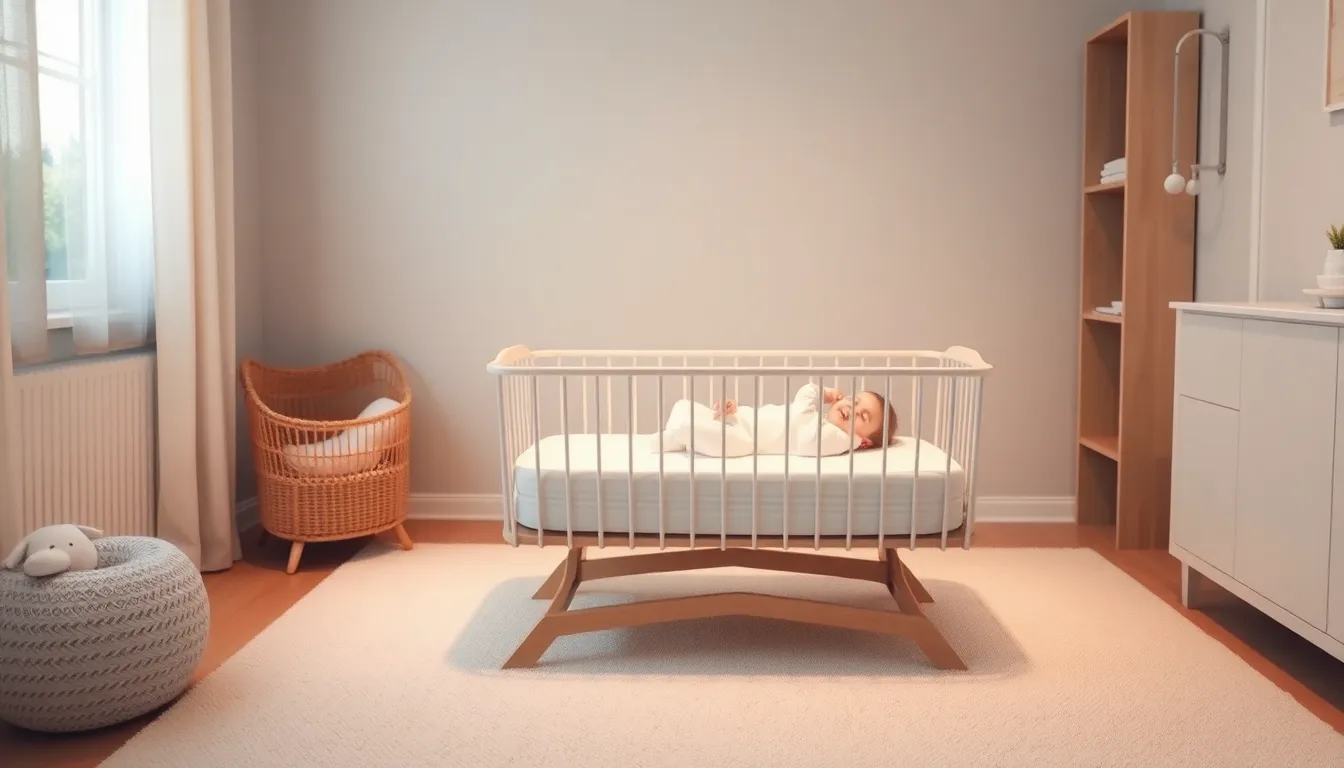Getting a baby to sleep in a bassinet can feel like trying to teach a cat to fetch—challenging and a bit chaotic. New parents often find themselves in a tug-of-war between their little one’s desire to be held and their own desperate need for sleep. The good news is, with a few clever strategies, that bassinet can become the ultimate sleep zone instead of a fancy baby-shaped torture device.
Table of Contents
ToggleUnderstanding Baby Sleep Patterns
Understanding a baby’s sleep patterns is crucial for successful sleep in a bassinet. Infants sleep in cycles that vary in length and depth.
Importance of Safe Sleep Environments
Safe sleep environments protect infants during rest. Each baby should sleep on their back in a crib or bassinet designed for safety. Using a firm, flat mattress reduces the risk of suffocation. Keeping the sleep area free of soft bedding and toys ensures a secure space. Parents must also keep the room at a comfortable temperature to prevent overheating. Adhering to these practices builds a foundation for healthy sleep habits.
Recognizing Sleep Cues
Recognizing sleep cues helps parents understand when their baby is ready to sleep. Typical signs include yawning, fussiness, or rubbing eyes. A calm demeanor replaces restlessness when a baby is tired. Noticing these indicators allows parents to prioritize sleep more effectively. Timing the transition to bed during these moments promotes easier settling into the bassinet. Responding promptly to sleep cues can lead to better nighttime rest for both the baby and parents.
Preparation Before Bedtime

Preparation plays a vital role in helping a baby sleep comfortably in a bassinet. Implementing a few strategies can set the stage for peaceful nights.
Establishing a Bedtime Routine
Consistent bedtime routines help signal sleep time to infants. Begin with calming activities like reading or gentle rocking. Bath time can also be a relaxing ritual, helping the baby unwind from the day’s excitement. Following these activities, offer a feeding session to ensure the baby is satisfied. Familiar sounds, such as lullabies or soft white noise, can further create a sleep-inducing environment. Throughout this process, consistency aids in establishing trust, making it easier for the baby to transition to sleep.
Creating a Comfortable Sleep Setting
A comfortable sleep setting significantly influences a baby’s ability to snooze in a bassinet. Ensure the bassinet features a firm and flat mattress, supporting safe sleep practices. Dress the baby in breathable fabrics to maintain a comfortable temperature without overheating. Adjust the room lighting to create a dim atmosphere mimicking nighttime. Using blackout curtains can effectively block out disruptive sunlight during daytime naps. Maintaining a quiet environment or implementing gentle white noise can mask disturbances and encourage deeper sleep.
Tips to Get Baby to Sleep in Bassinet
Implementing specific strategies can significantly improve a baby’s sleep in a bassinet. Parents can employ various techniques to create a soothing and cozy environment.
Swaddling Techniques
Swaddling provides a sense of security, mimicking the womb. Parents can use a lightweight, breathable fabric for comfort. Ensuring the swaddle is snug but not too tight can prevent the baby from startling awake. Adjusting the swaddle to allow for leg movement promotes healthy hip development. For added effectiveness, swaddle before putting the baby down to establish a calm atmosphere.
Using White Noise
White noise machines can create a consistent sound that masks background noise. Gentle, rhythmic sounds help relax babies, allowing them to sleep longer. The soothing sound lulls infants into deeper sleep phases. Parents can choose from various sounds, like a heartbeat or rain, based on their child’s preference. Placing the machine at a safe distance prevents overstimulation while still promoting a tranquil sleep environment.
Dimming the Lights
Dimming the lights prepares a baby for sleep by signaling nighttime. Reducing brightness helps establish a nighttime routine and naturally encourages sleepiness. Parents can use blackout curtains to minimize light exposure from outside sources. Soft lighting during pre-bedtime activities fosters relaxation and comfort. Gradually dimming the lights as bedtime approaches can support the sleep transition for the baby.
Managing Common Challenges
Navigating the journey of getting a baby to sleep in a bassinet presents unique challenges. Addressing fussy behavior and managing transitions can significantly impact sleep success.
Dealing with Fussiness
Fussiness often disrupts sleep patterns. Parents should first identify triggers of discomfort, like hunger or a dirty diaper. Establishing a soothing environment can make a difference. Holding the baby upright post-feeding can aid digestion and reduce fussiness. Gentle rocking or rhythmic bouncing may also calm an upset baby. A warm bath before bedtime can relax the baby, signaling that it’s time to wind down. Using a pacifier might provide comfort, allowing the baby to self-soothe.
Transitioning from Crib to Bassinet
Transitioning from a crib to a bassinet can present challenges. Parents can begin by placing the bassinet in the same room as the crib to help the baby adjust. Incorporating familiar smells or a favorite blanket into the bassinet creates a sense of security. Gradually introducing the bassinet during naps can ease the shift to nighttime sleep. Ensuring the bassinet is positioned in a quiet, low-traffic area enhances comfort. Parents might also establish consistent sleep routines to help the baby recognize when it’s time to sleep in the bassinet. Using gentle white noise during this transition can further promote relaxation and sleep.
Getting a baby to sleep in a bassinet can be a rewarding journey for parents. By implementing effective strategies and understanding the baby’s sleep needs, parents can create a soothing environment that encourages restful sleep.
Establishing a consistent bedtime routine and recognizing sleep cues are key components in helping infants transition comfortably to their bassinet. Utilizing techniques like swaddling and white noise can further enhance the sleep experience.
With patience and persistence, parents can foster a peaceful sleep atmosphere, ensuring both their baby and themselves can enjoy those precious moments of rest.



